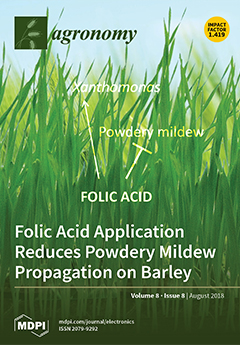The high adaptive potential of modern wheat to a wide range of environmental conditions is determined by genetic changes during domestication. Genetic diversity in
VRN1 genes is a key contributor to this adaptability. Previously, the association between the transitions C->T within the fourth and seventh exons of
VRN-A1, the distinguishing pair haplotypes Ex4C/Ex4T and Ex7C/Ex7T, and the modulation of such agronomically valuable traits as the vernalization requirement duration, frost tolerance and flowering time of wheat have been shown. However, this polymorphism was analyzed in only a few cultivars of
Triticum aestivum L., and not in other wheat species. In the present study,
VRN-A1 exon 4 and exon 7 were investigated in six tetraploid and five hexaploid wheat species carrying different
VRN-A1 alleles. An allele-specific polymerase chain reaction (PCR) assay was optimized to identify the
VRN-A1 exon 7 haplotypes. It was found that polymorphism of the
VRN-A1 exon 7 originated in wild tetraploid wheat of
Triticum dicoccoides Körn, while the mutant exon 4 of this gene originated later in domesticated hexaploid wheat of
T. aestivum. Both these polymorphisms are found in all hexaploid wheat species. Analysis of the
VRN-A1 exon 4 and exon 7 haplotype combinations found that intact exon 7 and mutant exon 4 are associated with analogous types of exon 4 and 7, respectively. With the exclusion of the
Vrn-A1c (
IL369) and
Vrn-A1j alleles, identified only in hexaploid wheat, all dominant
VRN-A1 alleles carry intact exons 4 and 7 (Ex4C/7C haplotype). The Ex4C/4T/7T haplotype was detected in numerous accessions of hexaploid wheat and is associated with the presence of multiple copies of
VRN-A1. Overall, modern domesticated hexaploid wheat
T. aestivum includes most possible combinations of the
VRN-A1 exon 4 and exon 7 haplotypes among polyploid wheat, which are present in different proportions. This contributes to the high adaptive potential to a broad range of environmental conditions and facilitates the widespread distribution of this species throughout the world.
Full article





